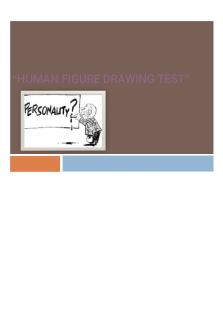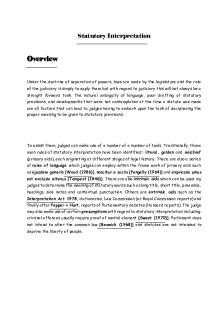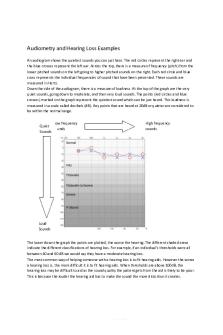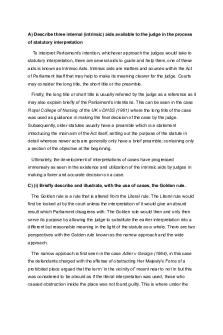Internal Aids - Interpretation PDF

| Title | Internal Aids - Interpretation |
|---|---|
| Course | Law, Society and Judicial Process |
| Institution | University of Kerala |
| Pages | 44 |
| File Size | 791.7 KB |
| File Type | |
| Total Downloads | 49 |
| Total Views | 139 |
Summary
Interpretation...
Description
CHAPTER3 AidstoInterpretation
CHAPTER 3 AIDS TO INTERPRETATION
1
Introduction
1.1
Internal Aid
1.1.1 Long Title 1.1.2 Preamble 1.1.3 Preamble to Constitution 1.1.4 Headings 1.1.5 Marginal Notes 1.1.6 Punctuations 1.1.7 Illustrations 1.1.8 Definition Section 1.1.9 Proviso 1.1.10 Explanation 1.1.11Non Obstante Clause 2.2
External Aid
2.2.1 History – Facts and Circumstances 2.2.2 Statement of Objects and Reasons 2.2.3 Dictionary 2.2.4 Precedents 2.2.5 Use of Foreign Decisions 3
Summary
338
1
INTRODUCTION This section tries to explore- how far beyond the actual words of
the statute itself is it permissible for courts to roam in their efforts to interpret legislation? Put another way, what is the proper context in which to interpret legislative directives? It is a question that is unavoidable intertwined with the more general problem of the proper approach to statutory interpretation, which in turn raises question about the proper constitutional functions of a court and the exercise of judicial discretion. Does a willingness to broaden the statutory context by consulting extrinsic material mean that the court is advocating a change in the court's function vis-a-vis the legislature and the executive. In the following analysis of some precedents from the highest court of the land, we make an attempt to clarify and delineate some of the underlying concerns that have supported the historically limited use of extrinsic evidence and also the recent trend in this regard. Unfortunately, the courts in India have not adopted a consistent and uniform approach to the use of extrinsic materials in the sense of determining what aids to interpretation, external to the statute under consideration, are legitimate and permissible, and the purpose for which this material might be used. 1.1
INTERNAL AID Traditionally, all the writers on interpretation of statutes consider
the preamble, title, heading, marginal notes, punctuation, illustrations, definitions, proviso, explanation etc. as internal aids.
339
By a long catena of decisions, it is now well settled that preamble is not a part of enactment. It is a recital to the intent of the legislature as it enumerates the mischiefs to be remedied. Though it is considered as a key to the construction of the statute, whenever the enacting part is open to doubt, it cannot restrict or extend the enacting part when the latter is free from doubt. However, in India, it is well settled in the field of constitutional law that the preamble to the Constitution of India and Directive Principles of State Policy are the guidelines for interpreting the constitutional provisions. We will deal with this a little while later. But there is nothing wrong for Courts to refer to the preamble as well as the title of the Act in construing the statute to know the intention of the legislature. Whenever there is a reasonable doubt about the provisions in the statute, it is permissible to refer to the heading of the provision for interpreting the section. Insofar as marginal notes inserted in the legislation itself are concerned, they are also treated as guidelines for interpreting the statutes. In many statutes, especially, penal statutes, enacted in the olden times, it is the practice of the legislature to give illustrations. The illustrations cannot be used either to cut down or extend the scope of the section. 1.1.1 LONG TITLE It is now settled that Long Title of an Act is a part of the Act and is admissible as an aid to its construction. The long title which often precedes the preamble must be distinguished with the short title; the former taken along with the preamble or even in its absence is a good guide regarding the object, scope or purpose of the Act, whereas the latter
340
being only an abbreviation for purposes of reference is not a useful aid to construction.804 While dealing with the Supreme Court Advocates (Practice in High Courts) Act, 1951, which bears a full title thus ‘An Act to authorise Advocates of the Supreme Court to practise as of right in any High Court, S. R. DAS, J., observed: “One cannot but be impressed at once with the wording of the full title of the Act. Although there are observations in earlier English cases that the title is not a part of the statute and is, therefore, to be excluded from consideration in construing the statutes, it is now settled law that the title of a statute is an important part of the Act and may be referred to for the purpose of ascertaining its general scope and of throwing light on its construction, although it cannot override the clear meaning of the enactment.805 The title of the Madras General Sales Tax, 1939, was utilised to indicate that the object of the Act is to impose taxes on sales that take place within the province.806 The title although part of the Act is in itself not an enacting provision and though useful in case of ambiguity of the enacting provisions, is ineffective to control their clear meaning. The long title of the Act – on which learned counsel placed considerable reliance as a guide for the determination of the scope of the Act and the policy underlying the legislation, no doubt, indicates the main
804
Justice G. P. Singh: Ibid, pp.105, 106 Aswinikumar Ghose v. Arabinda Bose, AIR 1952 SC pp.369, 388 806 Poppatlal Shah v. State of Madras, AIR 1953 SC 274 805
341
purposes of the enactment but cannot, obviously, control the express operative provisions of the Act.807 In the case of Amarendra Kumar Mohapatra & Ors. v. State of Orissa & Ors.,808 the Supreme Court has held that: “The title of a statute is no doubt an important part of an enactment and can be referred to for determining the general scope of the legislation. But the true nature of any such enactment has always to be determined not on the basis of the given to it but on the basis of its substance.” In M.P.V. Sundararamier & Co. v. State of A.P.,809 the Supreme Court was considering whether the impugned enactment was a Validation Act in the true sense. This Court held that although the short title as also the marginal note described the Act to be a Validation Act, the substance of the legislation did not answer that description. The Supreme Court observed: “31. ... It is argued that to validate is to confirm or ratify, and that can be only in respect of acts which one could have himself performed, and that if Parliament cannot enact a law relating to sales tax, it cannot validate such a law either, and that such a law is accordingly unauthorised and void. They only basis for this contention in the Act is its description in the short title as the ‘Sales Tax Laws Validation Act’ and the marginal note to Section 2, which is similarly worded. But the true nature of a law has to be determined not on the label given to it in the 807
Manoharlal v. State of Punjab, AIR 1961 SC pp.418, 419, as referred to by Justice G. P. Singh: Ibid, p.107 808 (2014) 4 SCC 583 809 AIR 1958 SC 468 342
statute but on its substance. Section 2 of the impugned Act which is the only substantive enactment therein makes no mention of any validation. It only provides that no law of a State imposing tax on sales shall be deemed to be invalid merely because such sales are in the course of inter-State trade or commerce. The effect of this provision is merely to liberate the State laws from the fetter placed on then by Article 286(2) and to enable such laws to operate on their own terms.” We may also refer to Maxwell,810 where on the basis of authorities on the subject, short title of the Act has been held to be irrelevant for the purpose of interpretations of statutes. Lord Moulton in Vacher and Sons Ltd. v. London Society of Compositors,811 described the short title of an Act as follows: “A title given to the Act is solely for the purpose of facility of reference. If I may use the phrase, it is a statutory nickname to obviate the necessity of always referring to the Act under its full and descriptive title ..... Its object is identification and not description.” 1.1.2 PREAMBLE The preamble of a statute like the long title is a part of the Act and is an admissible aid to construction. Although not an enacting part, the preamble is expected to express the scope, object and purpose of the Act more comprehensively than the long title. It may recite the ground and cause of making the statute, the evils sought to be remedied812 or the 810
Maxwell: Ibid, 12th Ed., p. 6 811 1913 AC 107 : (1911-13) All ER Rep 241 (HL) 812 The Secretary, Regional Transport Authority v. D.P. Sharma, AIR 1989 SC pp.509, 511 343
doubts which may be intended to be settled. In the words of SIR JOHN NICHOLL : “It is to the preamble more specifically that we are to look for the reason or spirit of every statute, rehearsing this, as it ordinarily does, the evils sought to be remedied, or the doubts purported to be removed by the statute, and so evidencing, in the best and most satisfactory manner, the object or intention of the Legislature in making or passing the statute itself.813 The principle has also been enunciated by the Supreme Court, where MUDHOLKAR, J., speaking for the court observed: “It is one of the cardinal principles of construction that where the language of an Act is clear, the preamble may be resorted to explain it. Again, where very general language is used in an enactment which, it is clear must be intended to have a limited application, the preamble may be used to indicate to what particular instances, the enactment is intended to apply. We cannot, therefore, start with the preamble for construing the provisions of an Act, though we could be justified in resorting to it, nay, we will be required to do so, if we find that the language used by Parliament is ambiguous or is too general though in point of fact parliament intended that it should have a limited application.814 The preamble may, no doubt, be used to solve any ambiguity or to fix the meaning of words which may have more than one meaning, but it
813 814
Brett v. Brett, (1826) 162 ER 456, pp. 458, 459 Burakar Coal Co. Ltd. v. Union of India, AIR 1961 SC pp.954, 956, 957; Venkataswami R. Naidu v. Narasram Naraindas, AIR 1966 SC pp.361, 363; Tribhuvan Parkash Nayyar v. Union of India, AIR 1970 SC pp.540, 543; Y. A. Mamarde v. Authority under the Minimum Wages Act, AIR 1972 SC pp.1721, 1726; A. C. Sharma v. Delhi Administration, AIR 1973 SC pp.913, 917 : 1973 SCC (Cri) 608; Rashtriya Mill Mazdoor Sangh v. National Textile Corporation, 1995 (6) Scale pp.609, 617 344
can, however, not be used to eliminate as redundant or unintended, the operative provision of a statute.815 A preamble retrospectively inserted into an earlier Act is not of much assistance for gathering the intention of the original Act. Similarly, it seems the repeal of a preamble simpliciter will not affect the construction of the Statute.816 1.1.3 PREAMBLE TO CONSTITUTION The Preamble of the Constitution like the Preamble of any statute furnishes the key to open the mind of the makers of the Constitution more so because the Constituent Assembly took great pains in formulating it so that it may reflect the essential features and basic objectives of the Constitution. The Preamble is a part of the Constitution.817 The Preamble embodies the fundamentals underlining the structure of the Constitution. It was adopted by the Constituent Assembly after the entire Constitution has been adopted. The true functions of the Preamble is to expound the nature and extend and application of the powers actually confirmed by the Constitution and not substantially to create them. The Constitution, including the Preamble, must be read as a whole and in case of doubt interpreted consistent with its basic structure to promote the great objectives stated in the preamble. But the Preamble can neither be regarded as the source of any substantive power nor as a source of any prohibition or limitation.818 The Preamble of a Constitution Amendment Act can be used to understand the object of the amendment. 815
State of Rajasthan v. Leela Jain, AIR 1965 SC pp.1296, 1299 CRAIES: Statute Law, 7th Ed., p. 206; as referred to by Justice G. P. Singh: Ibid, pp.113, 114 817 Justice G.P. Singh: Ibid, p. 114 818 Indira Nehru Gandhi (Smt.) v. Raj Narain, AIR 1975 SC 2299; Raghunath Rao Ganpat Rao v. Union of India, AIR 1993 SC 1267
816
345
The majority judgments in Keshavanand and Minerva Mills strongly relied upon the Preamble in reaching the conclusion that the power of amendment conferred by Article 368 was limited and did not enable Parliament to alter the basic structure or framework of the Constitution.819 1.1.4 HEADINGS The view is now settled that the Headings or Titles prefixed to sections or group of sections can be referred to in construing an Act of the Legislature.820 But conflicting opinions have been expressed on the question as to what weight should be attached to the headings. “A Heading”, according to one view, “is to be regarded as giving the key to the interpretation of the clauses ranged under it, unless the wording is inconsistent with such interpretation;821 and so the headings might be treated “as preambles to the provisions following them.”822 Recently the Supreme Court expressed itself as follows: “It is well settled that the headings prefixed to sections or entries (of a Tariff Schedule) cannot control the plain words of the provisions; they cannot also be referred to for the purpose of construing the provision when the words used in the provision are clear and unambiguous; nor can they be used for cutting down the plain meaning of the words in the provision. 819
Kesavananda v. State of Kerala, AIR 1973 SC 1461 : (1973) 4 SCC 225; Minerva Mills Ltd. v. Union of India, AIR 1980 SC pp.1789, 1798, 1806 820 Hammer Smith & City Ry v. Brand, (1869) LR 4 HLC 171; Ingils v. Robertson (1898) AC pp.616, 624, 629 (HL); Toronto Corporation v. Toronto Ry, (1907) AC (PC) pp.315, 324; Martins v. Fowler, (1926) AC (PC) pp.746. 750; Qualter Hall & Co. Ltd. v. Board of Trade, (1961) 3 All ER (CA) pp. 389, 392, 394; Bhinka v. Charan Singh, AIR 1959 SC pp.960, 966; Director of Public Prosecutions v. Schildkamp, (1969) 3 All ER 1640 (HL) 821 Toronto Corporation v. Toronto Ry Co., Ibid, p. 324; Re Ralpph George Cariton, (1945) 1 All ER pp.559, 562; Qualter Hall & Co. v. Board of Trade, Ibid, p. 392 822 Martins v. Fowler, Ibid, p. 750 : Qualter Hall & Co. v. Board of Trade, Ibid, p. 392 346
Only in the case of ambiguity or doubt the heading or sub-heading may be referred to as an aid in construing the provision but even in such a case it could not be used for cutting down the wide application of the clear words used in the provision.”823 “The heading prefixed to sections or sets or sections in some modern statutes are regarded as preambles to those sections. They cannot control the plain words of the statute but they may explain ambiguous words.”824 1.1.5 MARGINAL NOTES In the older statutes marginal notes were not inserted by the legislature and hence were not part of the statute and could not be referred to for the purpose of construing the statute. If they are also enacted by the legislature they can be referred to for the purpose of interpretation. In the case of the Indian Constitution, the marginal notes have been enacted by the Constituent Assembly and hence they may be referred to for interpreting the Articles of the Constitution. If the words used in the enactment are clear and unambiguous, the marginal note cannot control the meaning, but in case of ambiguity or doubt, the marginal note may be referred to.825 In the case of Thakurain Balraj Kunwar v. Rao Jagpatpal Singh,826 it was observed that it is well settled that marginal notes to the sections of an Act of Parliament cannot be referred to for the purpose of construing the Act.
823
M/s. Frick India Ltd. v. Union of India, AIR 1990 SC pp.689, 693 Bhinka v. Charan Singh, AIR 1959 SC pp.960, 966; as referred to in Maxwell: Ibid, 11th Ed., pp. 48, 49 825 Vipa P. Sarathi: Ibid, p. 258 826 (1904) ILR 26 All 393 (PC) as referred to by Vipa P. Sarathi, Ibid, p. 258 824
347
There can be no justification for restricting the contents of the section by the marginal note.827 The marginal note cannot affect the construction of the language used in the body of the section if it is otherwise clear and ambiguous.828 The marginal heading cannot control the interpretation of the words of the section particularly when the language of the section is clear and unambiguous.829 Where the language is clear and can admit of no other meaning, the marginal note cannot be read to control the provisions of the statute.830 “Marginal notes in an Indian statute, as in an Act of Parliament cannot be referred to for the purpose of construing the statute.”831 Although a marginal note may not be determinative of the content of the provision, it may act as an intrinsic aid to construction.”832 1.1.6 PUNCTUATIONS ‘Punctuation’ means to mark with points and to make points with usual stops. It is the art of dividing sentences by point or mark. Is the Court entitled to use punctuation also while interpreting the statutes? Punctuation is considered as a minor element in the construction of statutes. Text book writers comment that English Court pay little or no attention to punctuation while interpreting while interpreting the statutes. The same is not the cases in Indian Courts. If a statute in question is found to be carefully punctuated, punctuation may be resorted for the 827
Emperor v. Sadashiv, AIR 1947 PC 82 Western India Theaters Ltd. v. Municipal Corporation Puna, AIR 1959 SC 586 829 Chandroji Rao v. Income Tax Commissioner, AIR 1970 SC 1582 830 Charan Lal Sahu v. Nand Kishor Bhatt, (1973) 2 SCC 530 831 C.I.T. v. Ahmedbhai Umarbhai & Co., AIR 1950 SC pp.134, 141; Board of Muslim Waqfs, Rajasthan v. Radhakishan, AIR 1979 SC pp.289, 295, 296 : (1979) 2 SCC 468; Kalawati Bai v. Soiryabai, AIR 1991 SC pp.1581, 1586; as referred to by Justice G. P. Singh: Ibid, p. 118 832 Smt. Nandini Satpathy v. P.L. Dani and Anr., AIR 1978 SC 1025; Bombay Dying and Manufacturing Co. Ltd. v. Bombay Environmental Action Group, AIR 2006 SC 1489
828
348
purpose of construction. In Mohd. Shabbir v. State of Maharashtra,833 while interpreting Section 27 of the Drugs and Cosmetics Act, 1940, the Supreme Court pointed out that the presence of ‘comma’ after ‘manufactures for sale’ and ‘sells’, and absence of any ‘comma’ after ‘stocks’ would indicate that only stocking for sale could amount to offence and that mere stocking cannot be treated as an offence for the purpose of the Drugs and Cosmetics Act. Another important internal aid is the schedule or schedules appended to a statute. It forms part of the statute and it can be interpreted independently as well as with the aids of interpretation of statutory provision. B. K. MUKHERJEE, J., in Aswini Kumar Ghose v. Arabinda Bose,834 expressed himself as follows: “Punctuation is after all a minor element in the construction of a statute, and very little attention is paid to it by English Courts-. It seems, however, that in the vellum copies printed since 1850, there are some cases of punctuation, and when they occur they can be looked upon as a sort of contemporancea expositio-. When a statute is carefully punctuated and there is doubt about its meaning, a weight should...
Similar Free PDFs

Internal Aids - Interpretation
- 44 Pages

Aids to interpretation
- 8 Pages

MAKALAH AIDS
- 17 Pages

Textual AIDS - Grade: 10
- 2 Pages

ASUHAN KEPERAWATAN AIDS
- 31 Pages

Walking aids
- 2 Pages

Makalah HIV/AIDS
- 1 Pages

HFD Interpretation
- 42 Pages

Statutory Interpretation
- 5 Pages

Statutory Interpretation
- 11 Pages

Audiogram Interpretation
- 12 Pages

Interpretation schreiben
- 2 Pages

Statutory Interpretation
- 3 Pages

LFT Interpretation
- 5 Pages
Popular Institutions
- Tinajero National High School - Annex
- Politeknik Caltex Riau
- Yokohama City University
- SGT University
- University of Al-Qadisiyah
- Divine Word College of Vigan
- Techniek College Rotterdam
- Universidade de Santiago
- Universiti Teknologi MARA Cawangan Johor Kampus Pasir Gudang
- Poltekkes Kemenkes Yogyakarta
- Baguio City National High School
- Colegio san marcos
- preparatoria uno
- Centro de Bachillerato Tecnológico Industrial y de Servicios No. 107
- Dalian Maritime University
- Quang Trung Secondary School
- Colegio Tecnológico en Informática
- Corporación Regional de Educación Superior
- Grupo CEDVA
- Dar Al Uloom University
- Centro de Estudios Preuniversitarios de la Universidad Nacional de Ingeniería
- 上智大学
- Aakash International School, Nuna Majara
- San Felipe Neri Catholic School
- Kang Chiao International School - New Taipei City
- Misamis Occidental National High School
- Institución Educativa Escuela Normal Juan Ladrilleros
- Kolehiyo ng Pantukan
- Batanes State College
- Instituto Continental
- Sekolah Menengah Kejuruan Kesehatan Kaltara (Tarakan)
- Colegio de La Inmaculada Concepcion - Cebu

